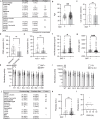Features of chronic urticaria after COVID-19 mRNA vaccine over time
- PMID: 39616213
- PMCID: PMC11608360
- DOI: 10.1038/s43856-024-00656-y
Features of chronic urticaria after COVID-19 mRNA vaccine over time
Abstract
Background: New onsets of chronic urticaria (CU) have been reported after repeated immunizations, mainly with the Moderna mRNA-1273 vaccine (Spikevax). This study aims to evaluate patients with CU after COVID-19 mRNA vaccination. The contribution of SARS-Cov2 infection, atopy and IgE against the vaccine was analyzed.
Methods: We monitored the features of patients who developed CU after vaccination through two surveys conducted in 2022 and 2023. Fifty individuals with CU underwent blood tests, and their results were compared with individuals without a history of urticaria (N = 135). The presence of anti-vaccine IgE was tested in 185 individuals with basophil activation tests (BAT). We assessed anti-SARS-Cov2 humoral response, and the presence of IgEs against common respiratory allergens (Phadiatop) as a surrogate for atopy.
Results: Post-vaccination CU occurs after a median interval of 10 days and significantly more after the Spikevax booster, affecting middle-aged individuals (median 41, 66% females). In 2023, CU was still active in 53% of the cases. Inducible forms of CU, primarily dermographism, are reported in 54% (2022) and 61% (2023) of the cases. BAT positivity is not specific to CU, anti-nucleocapsid positivity, or atopy but is significantly associated with higher anti-spike neutralizing activities and younger age. Four CU patients tolerate an additional dose of mRNA vaccine with no disease exacerbation/recurrence.
Conclusions: The spikevax booster induces anti-vaccine IgE independently of CU, the latter being not directly associated with COVID-19 infection nor atopy. The tolerance to a new booster in 4/4 patients suggests that the Spikevax vaccine indirectly triggers CU in predisposed individuals.
Plain language summary
Urticaria is an itchy transient skin rash which can become in some cases recurrent and chronic. Repeated immunizations with COVID-19 mRNA vaccines can rarely lead to the development of chronic urticaria (CU), on average 10 days after vaccination. Here, we monitored people who developed CU after vaccination. One year following vaccination 53% of people still had CU. CU after vaccination was not directly associated with COVID infection, allergic predisposition or other effects of vaccination. Re-exposure to the vaccine was safe and well tolerated in four patients with vaccine-related CU suggesting an absence of a direct causality between the vaccine and CU. Therefore, managing CU post-vaccination should follow previously established guidelines as for other forms of CU.
© 2024. The Author(s).
Conflict of interest statement
Competing interests: The authors declare the following competing interests: Dr Fenwick report having a patent pending (application No. EP20205298.1) for a SARS-Cov2 neutralization assay. Prof. Muller has received grant support/consulting income from AstraZeneca, Viatris, Blueprint Medicine, Sanofi and GSK. Prof. Didierlaurent received research grants from Moderna, GSK and Sanofi outside the scope of this study. The research was conducted without any other commercial or financial relationships that could be construed as a potential conflict of interest to this study. Authors J. Schwab, M. Foglierini, E. Pescosolido, I. Pacheco, G. A. Ruiz Buendía, N. Madelon, C. Pellaton, V. Banderet, C. Ribi, M. M. Bergmann, and O. Duperrex declare no competing interests relevant to this study.
Figures




References
-
- Public Summary SwissPAR—Spikevax® [Internet]. Available from https://www.swissmedic.ch/swissmedic/fr/home/ueber (2023).
-
- Comirnaty®, Concentré pour reconstitution d’une dispersion injectable (Tozinameranum) [Internet]. Available from https://www.swissmedic.ch/swissmedic/fr/home/humanarzneimittel/authorisa... (2023).
-
- Swissmedic octroie une autorisation de durée limitée au vaccin Nuvaxovid de Novavax contre le Covid-19 [Internet]. [cited 2023 Aug 10]. Available from https://www.swissmedic.ch/swissmedic/fr/home/news/coronavirus-covid-19/z....
-
- Contrats d’acquisition des vaccins COVID-19 [Internet]. Available from https://www.bag.admin.ch/bag/fr/home/krankheiten/ausbrueche-epidemien-pa... (2023).
LinkOut - more resources
Full Text Sources
Miscellaneous

